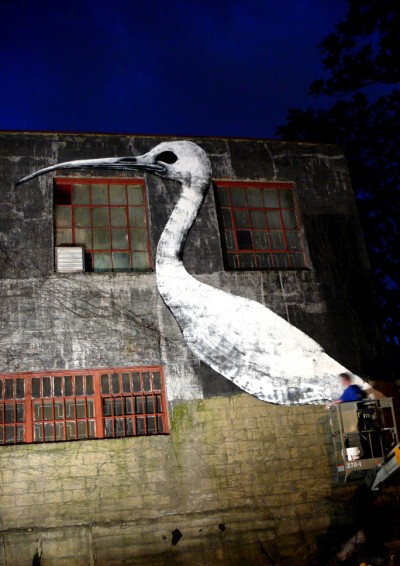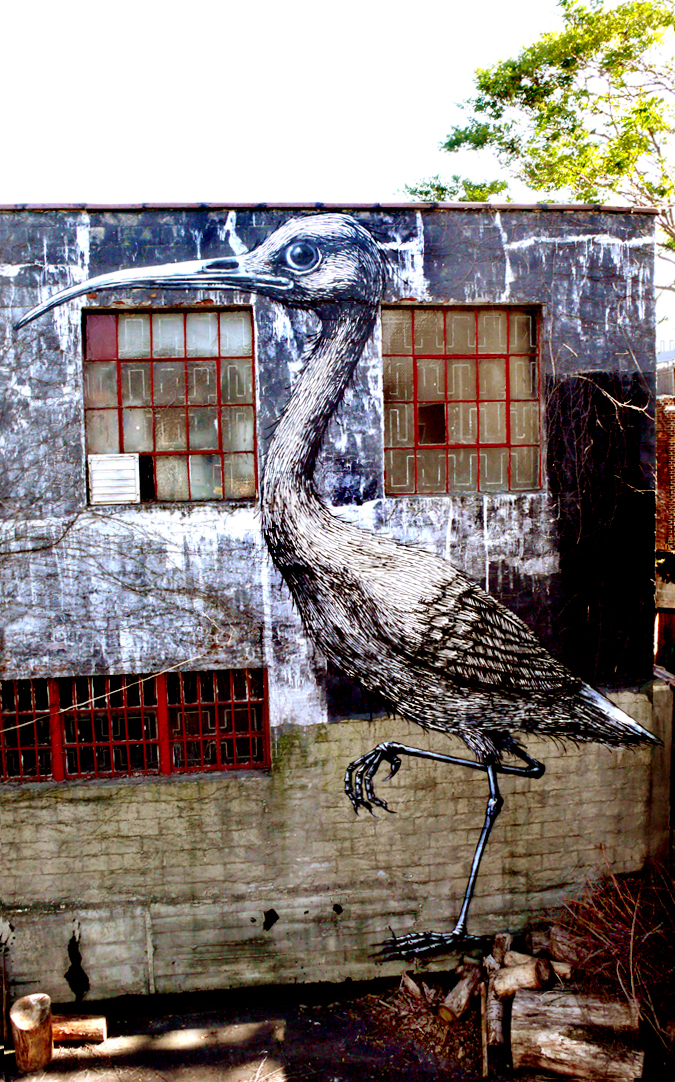As the sun sets, a mighty and serene Ibis rises 35 feet on a battered Brooklyn wall
ROA begins his portrait of the Ibis, a wading bird common in the marshes on the mid-Atlantic coast of the US. (photo © Jaime Rojo)
Today we continue with our coverage of ROA’s arrival into New York and his second piece this week, a stunning long-necked Ibis on a tattered and weathered former rope factory in Brooklyn.
We all took turns on the cherry picker (hooked up by our buddy Joe F. ) which was a blast to operate and after we scraped the wall free of ivy and managed to not smash any windows, ROA hopped inside and put on his safety harness and drove that bucket smoothly, like your grandpa on a Sunday drive through the countryside.
Using only his eye, his spray can, and a confident hand, ROA mapped out the shape of the feathered creature with no false lines, and no chance of erasing. Periodically he brought the mechanical bird to the ground to step way back and assess his progress and make adjustments: the wild animals’ belly got a little fatter, the feathers more shading for depth. As the sun receded and the lights came on, the painting of the Ibis felt more like an “event”, a performance onstage in the floodlights by one of Street Arts’ rising talents who can command a stage and keep it real.
In Part 2 of ROA’s interview, he talked to BSA about his roots in graffiti, his transition to Street Art, and a few words about our move to the second wave of the street art movement. (see Part I here)
Brooklyn Street Art: How long have you been making animals?
ROA: I think I had a big period when I did all kinds of stuff – from letters to whatever when I was younger. Then I started doing characters. Then for myself I really changed my way of painting and I found out that I really wanted to paint animals. This is a couple of years ago. But then when I look back to the stuff I did when I was younger, there were some earlier tags that were, at that point, not important for myself but when I look at them now I realize that they were already there. In the last few years I think I really know what I am doing. There were signs that told what I might become.
Brooklyn Street Art: So you were writing graffiti first, lettering, tags?
ROA: Yeah, I started when I was like 13 so we copied things out of Spray Can Art and Subway Art – these things were for us like The Bible or something. So if we had a vision of how a piece should be it was like things we saw in these books — colors and a black outline and a white highlight. So for a long time that was what we did.
Brooklyn Street Art: These books were like textbooks for the school of graffiti.
ROA: In a way, definitely. When I started doing that I started skating and listening to Public Enemy. As a Belgian kid growing up in the late 80’s – early 90’s that was the strong influence, these kinds of things – so graffiti was one of these things. So in our minds, it should be done like that. So I think at that point nobody was doing anything else, there was just old-school graffiti..
Brooklyn Street Art: It had become globalized at that point…
ROA: And it is still there. It’s still being repeated now.
Brooklyn Street Art: When did you first see that there began to be a little divide in the graffiti/street art evolution? When did you first get an inkling that things were changing?
ROA: I think because I started to do different stuff, I started to see that there was different stuff. It was not really obvious. People were doing things that were more “characters” like a hip-hop MC with a cute female with a big butt and a chain around (the neck) and a big ghetto blaster. Then at certain points people started painting less of the MC styles – they started to paint extra old-school and “crappy “– in a deliberate way because they wanted “crappy”. A few years ago this was the first “unconventional” graffiti that I started to see – they tried to look crappy. That was for me the first moment that I started to notice a change. And that was the moment when I started to say “you have new styles”. It shouldn’t just be just the old style. You have new styles.
Brooklyn Street Art: So perhaps you had exhausted that vocabulary. You had done everything that you wanted to do and you wanted to discover something different.
ROA: I realized that I wanted to do something different. I had been drawing all my life and I sketched a lot. Most often my sketches were way more powerful than the finished pieces on the wall. So the moment I started to “sketch” with a can, that was the moment when I started to see for myself the change. When I stopped doing surfaces and I started doing lines… It is just a way of painting or drawing. You have a certain kind of culture where it came from but aside from that – it’s just paint and a surface to paint on so at that point I realized that there are so many things you can do and ways you can try to do it with spray paint.
Brooklyn Street Art: So now the proverbial horse is out of the barn and there is no use closing the door..
ROA: Yeah, I think so. It’s too late, that’s for sure. Of course you don’t know what the future will bring and I’m not saying I’m going to do forever what I am doing now. I try to keep on pushing it farther and sometimes I take two steps back and re-examine. It is not always clear, that’s the nice thing.
Brooklyn Street Art: So, for you it is like an evolution.
ROA: Yeah, I think so. It’s an endless evolution. That’s what is so nice about drawing or making stuff. It’s like a piece – when is it finished? Never. You can work on it for hours and hours more and then “Is it finished?” – you never know, eh? It’s like with drawing, too..… when are you a skilled artist? When you die probably, then. Then you are at the end of your journey, then you know what you know. Then you can not know more. Until then you can learn every day. With drawing it is not like a game you can complete. There is always a new level. Even if you get to the next level, then you have ten new levels. That is a nice thing about it, there is no ending.
Regarding the first wave of Street Art:
ROA: …everybody found a style and repeated it over and over and it was all around and people saw it and it was crazy what you could do with one small logo. Then at a certain point, it gets boring too. If you have the same logo over and over — I’m not the guy who says what other people should do, though. I want to do what I want to do.
Brooklyn Street Art: So you feel like now we can identify some of those practices as being a part of the “first wave” of street art?
ROA: I think that made a big difference. Then people made logos and t-shirts and toys and calendars and condoms and whatever, which is ,in a way, really funny. You can do it with stuff like that and you can be all over. But at this point I think we are at a new level and people can do stuff like that but it is more interesting if somebody does stuff with it and it continues and it grows and it lives and you can be surprised by most of the new work. It is not like this symbol repeated again and again with a different color and a little slight twist. In the end, it’s been done. Sometimes it is time to move. When DuChamp put his urinal in the museum it was really one of the biggest statements of the last century. Definitely. But the next guy who did something similar was less interesting. If you see what was done later in the same tracks, it’s really boring. It’s good that things get knocked down and rebuilt and knocked down.
Don’t miss ROA in his first New York Solo Show at Factory Fresh May 14.
 BROOKLYN STREET ART LOVES YOU MORE EVERY DAY
BROOKLYN STREET ART LOVES YOU MORE EVERY DAY











